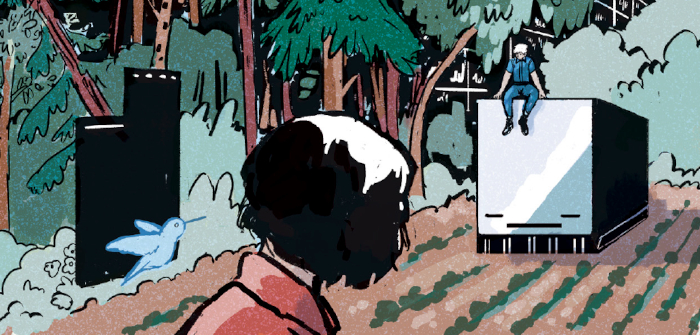Follow us at https://bsky.app/profile/deconcomics.bsky.social !

Follow us at https://bsky.app/profile/deconcomics.bsky.social !


While the last three issues of Captain America and the Falcon we looked at were rather underwhelming, issues 209 to 211 give us all the kooky science fiction and Kirby Crackle we could want! The appearance of Arnim Zola, in his first face-off with Cap, has revitalized the story. But Falcon seems shunted off to the side, and what the heck happened to Anna Maria’s personality?? Tim and Emmet discuss these three issues.
Brought to you by:
Podcast: Play in new window | Download

We conclude our look at 2015’s Fant4stic, directed by Josh Trank. Trank’s behavior on the set (and on Twitter) have been nothing but bad for his career, and studio meddling was nothing but bad for a film that wasn’t a good take on the FF, but might have at least been a better film if Trank had been left alone. As it was, we’re left with yet another FF movie that’s short on explanations of Dr. Doom’s objectives.
Videos drawn on for this episode:
Brought to you by:
Podcast: Play in new window | Download

Should a director re-interpret a property when nobody wanted it re-interpreted? 2015’s Fant4stic, directed by Josh Trank, turns getting superpowers into an exercise in body horror. Much of its inspiration comes from Bendis and Millar’s very straightfaced Ultimate Fantastic Four comics, Trank threw in a liberal helping of The Fly and Scanners. Tim, Kumar, and Jordan (in another crossover with the Comic Book Movie Oblivion podcast) look at the first appearance of the Negative Zone in Fantastic Four #51 by Lee and Kirby, and at Ultimate Fantastic Four v. 1, before beginning a look at the film itself.
Brought to you by:
Podcast: Play in new window | Download

After the (connected) short stories of Safer Places, Kit Anderson‘s new book is a full-on graphic novel called Second Shift (again from Avery Hill) which has gotten some breathlessly positive reviews from writers who give the impression they totally understand it. At Deconstructing Comics, our reviews tend to be more nuanced. What did we think of it? I’m joined by Loyala Marymount University professor Juan Mah y Busch to examine this book, and we’re not afraid to say we found it difficult to understand!
Brought to you by:
Podcast: Play in new window | Download

FLASHBACK! Eileen Gray: A House Under the Sun is a slim graphic novel by Charlotte Malterre-Barthes and Zosia Dzierzawska, about the titular famous Irish architect that most people have never heard of. Kumar and Emmet found it beautiful and intriguing; here’s their review. (Originally published August 28, 2019.) This episode includes a new intro from Emmet, referring to the recent film about Gray.
Brought to you by:
Podcast: Play in new window | Download

Ken Krimstein‘s Einstein in Kafkaland: How Albert Fell Down the Rabbit Hole and Came up with the Universe builds on the fact that these two stars of the early 20th century were part of the same friend group at one point and builds it up into what NPR described as “Alice in Wonderland meets The Lives of the Poets meets Krazy Kat.” This week Emmet talks with Ken about the book, the two historical figures featured in it, and the nature of comics itself.
Brought to you by:
Podcast: Play in new window | Download

Podcast: Play in new window | Download

FLASHBACK! The 1990s DC series Starman is one of comicdom’s most fondly remembered series. Interestingly, says series author James Robinson, it seems to be more popular now than it was when it was actually in production! James joins Tim and Ryan Haupt this week to look back on various aspects of this iconic series, including the theme of “legacy”, a sneaky crossover with another series, a story arc that never happened, the differences in how the Big Two have dealt with their Golden Age characters, and much more. (Originally published January 6, 2014)
James Robinson on Science…Sort Of in October 2009
Brought to you by:
Podcast: Play in new window | Download

Fables of Fear is an anthology horror title by Karl Brandt and David Parsons. Tim and Adam discuss; there are some good short stories here, but maybe they’re a bit … TOO short?
Black Plastic, by Josh Tierney and Nicci Busse is, as its writer says, a “karaoke cyber-thriller” graphic novel. That’s his description; Tim and Jason aren’t quite sure what to think of it. Are we getting too old for this comics-critique stuff?
Brought to you by:
Podcast: Play in new window | Download

FLASHBACK! This week a wide-ranging discussion between two Canadians, Koom and Ian, about comics in Canada. The talk centers on Montreal-based publisher Drawn & Quarterly, and two books from their catalog: Michel Rabagliati’s 2005 book Paul Moves Out, and the latest from Jillian Tamaki, Boundless. Also, some deep background on the history and people behind Toronto comics shop The Beguiling. (Originally published August 7, 2017)
Brought to you by:
Podcast: Play in new window | Download